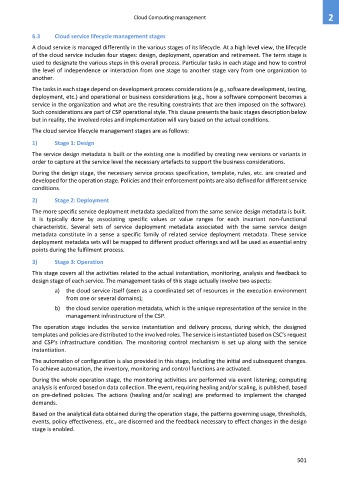Page 509 - Cloud computing: From paradigm to operation
P. 509
Cloud Computing management 2
6.3 Cloud service lifecycle management stages
A cloud service is managed differently in the various stages of its lifecycle. At a high level view, the lifecycle
of the cloud service includes four stages: design, deployment, operation and retirement. The term stage is
used to designate the various steps in this overall process. Particular tasks in each stage and how to control
the level of independence or interaction from one stage to another stage vary from one organization to
another.
The tasks in each stage depend on development process considerations (e.g., software development, testing,
deployment, etc.) and operational or business considerations (e.g., how a software component becomes a
service in the organization and what are the resulting constraints that are then imposed on the software).
Such considerations are part of CSP operational style. This clause presents the basic stages description below
but in reality, the involved roles and implementation will vary based on the actual conditions.
The cloud service lifecycle management stages are as follows:
1) Stage 1: Design
The service design metadata is built or the existing one is modified by creating new versions or variants in
order to capture at the service level the necessary artefacts to support the business considerations.
During the design stage, the necessary service process specification, template, rules, etc. are created and
developed for the operation stage. Policies and their enforcement points are also defined for different service
conditions.
2) Stage 2: Deployment
The more specific service deployment metadata specialized from the same service design metadata is built.
It is typically done by associating specific values or value ranges for each invariant non-functional
characteristic. Several sets of service deployment metadata associated with the same service design
metadata constitute in a sense a specific family of related service deployment metadata. These service
deployment metadata sets will be mapped to different product offerings and will be used as essential entry
points during the fulfilment process.
3) Stage 3: Operation
This stage covers all the activities related to the actual instantiation, monitoring, analysis and feedback to
design stage of each service. The management tasks of this stage actually involve two aspects:
a) the cloud service itself (seen as a coordinated set of resources in the execution environment
from one or several domains);
b) the cloud service operation metadata, which is the unique representation of the service in the
management infrastructure of the CSP.
The operation stage includes the service instantiation and delivery process, during which, the designed
templates and policies are distributed to the involved roles. The service is instantiated based on CSC's request
and CSP's infrastructure condition. The monitoring control mechanism is set up along with the service
instantiation.
The automation of configuration is also provided in this stage, including the initial and subsequent changes.
To achieve automation, the inventory, monitoring and control functions are activated.
During the whole operation stage, the monitoring activities are performed via event listening; computing
analysis is enforced based on data collection. The event, requiring healing and/or scaling, is published, based
on pre-defined policies. The actions (healing and/or scaling) are preformed to implement the changed
demands.
Based on the analytical data obtained during the operation stage, the patterns governing usage, thresholds,
events, policy effectiveness, etc., are discerned and the feedback necessary to effect changes in the design
stage is enabled.
501

